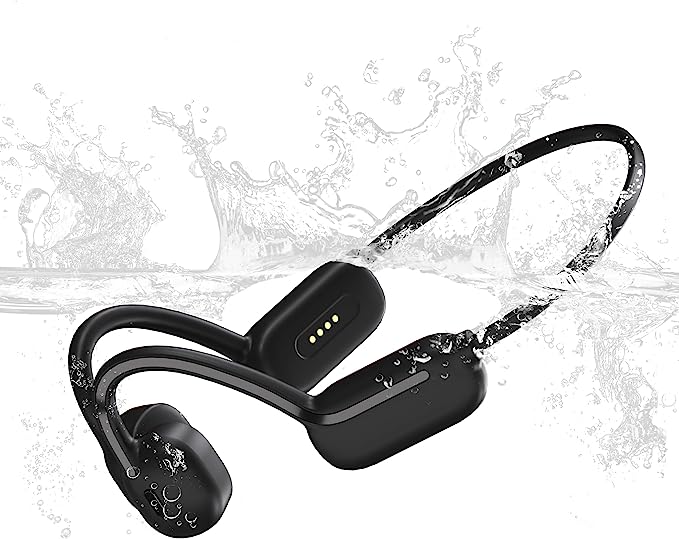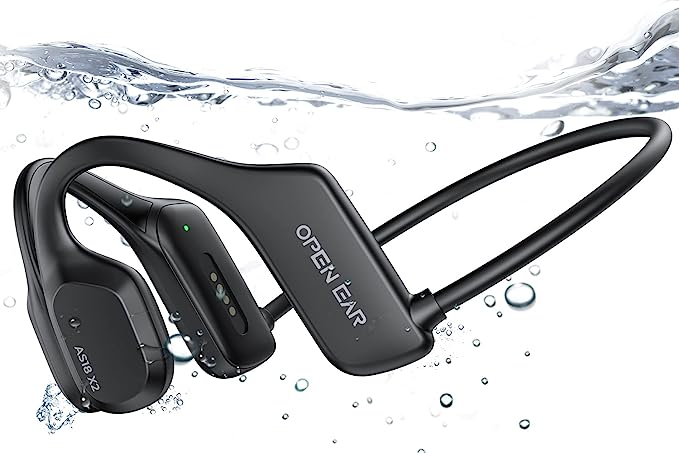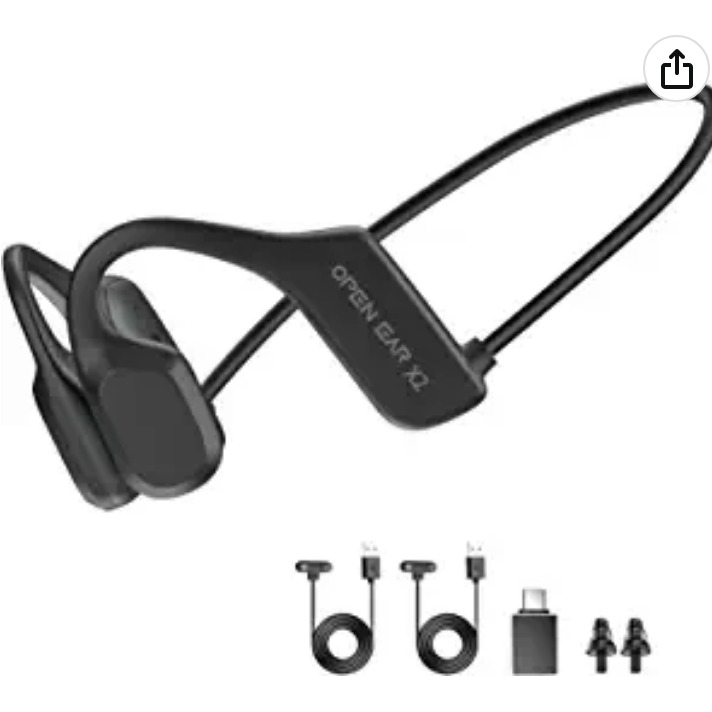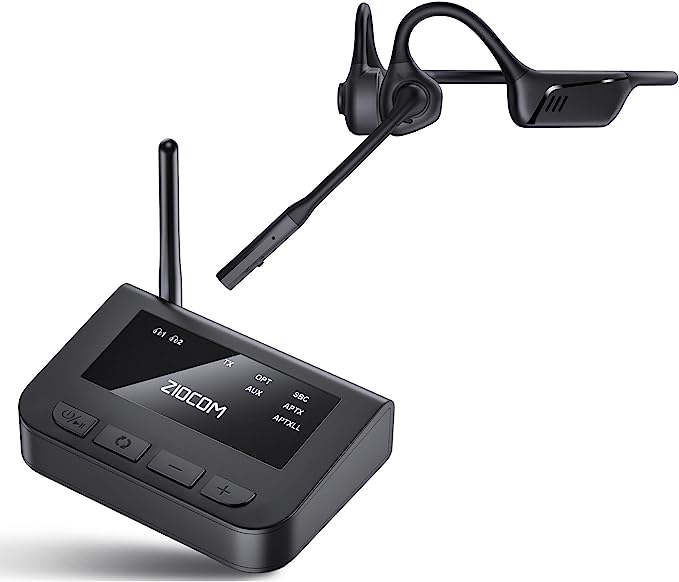iqua iquaG100 Gemini Bone Conduction Headphones: An Open-Ear Audio Solution
Update on June 20, 2025, 1:27 p.m.
We live in a world saturated with sound, a vibrant tapestry woven from conversations, the rhythm of city life, the whispers of nature, and, of course, our own curated soundtracks. But how often do we face the dilemma of wanting to lose ourselves in music or a captivating podcast, while simultaneously needing to stay connected and aware of the environment around us? It’s a common modern challenge: the desire for auditory immersion versus the necessity of situational awareness. This is where the fascinating science of alternative audio transmission steps in, and where innovative devices like the iqua iquaG100 Gemini Bone Conduction Headphones offer not just a solution, but a new way to experience your auditory world.

A Different Kind of Symphony: How Bone Conduction Plays Your Skull
Think about how you typically hear. Sound waves, elegant disturbances in the air, embark on a journey into your ear canal. They cause your eardrum to vibrate, a delicate membrane acting as the first gateway. These vibrations are then dutifully passed along by a trio of tiny bones in your middle ear – the ossicles – eventually reaching the cochlea, a spiral-shaped marvel in your inner ear. Here, the mechanical vibrations are magically transformed into electrical signals that your brain interprets as the rich sounds of life. This is air conduction, the pathway we’re most familiar with.

Now, imagine a shortcut, a more direct route for sound, one that bypasses the ear canal and eardrum altogether. This is the essence of bone conduction. Instead of speakers nestled in or over your ears, bone conduction headphones, like the iquaG100 Gemini, feature transducers that rest gently on your cheekbones, specifically the zygomatic arch. These transducers convert audio signals into subtle mechanical vibrations. It’s a bit like feeling the deep bass notes vibrate through the floor at a concert, only far more refined and precise. These vibrations travel through the bones of your skull – solid, surprisingly efficient conductors of sound – directly to your cochlea. Your inner ear receives the sound information just as clearly, but your ear canals remain completely open.
The immediate, and perhaps most profound, implication of this open-ear design is enhanced situational awareness. You can be engrossed in your favorite playlist while still hearing a bicycle bell behind you, a car approaching, or a colleague calling your name in the office. This isn’t just a convenience; it’s a significant safety feature for anyone active outdoors or navigating busy environments. Interestingly, the concept isn’t entirely new. Legend has it that the great composer Ludwig van Beethoven, as his hearing declined, would bite one end of a wooden rod and place the other against his piano, allowing him to “hear” the music through the vibrations conducted by his jawbone – a rudimentary, yet effective, demonstration of bone conduction. Modern science, of course, has refined this principle into sophisticated wearable technology.

The Gemini Principle: Two Paths, One Headset, Infinite Possibilities
The iqua iquaG100 Gemini, however, doesn’t just rest on the laurels of bone conduction. Its very name, “Gemini,” hints at a duality, a clever “choice architecture” engineered into its design. It acknowledges that sometimes you need that open-ear awareness, and other times, you crave a more traditional, immersive sound experience.
-
Path One: The Open-Ear Sentinel (Bone Conduction Mode)
This is your go-to when connection to your surroundings is paramount. Imagine your morning run through a bustling park; the G100 Gemini in bone conduction mode delivers your energizing tunes while keeping you alert to fellow joggers, cyclists, and the ambient sounds of nature. Picture yourself cycling through city streets; you hear your GPS directions clearly, yet remain aware of traffic. In an open-plan office, you can listen to a focus-enhancing playlist without completely tuning out important announcements or a nearby conversation. This mode is about the science of presence, allowing audio to complement your environment rather than occlude it. -
Path Two: The Immersive Cocoon (In-Ear Dynamic Driver Mode)
But what about those times when you want to shut out the world and dive deep into your audio? Perhaps it’s for intense, focused work, a long commute where you want to lose yourself in an audiobook, or simply a moment of private listening. The G100 Gemini ingeniously allows you to detach the bone conduction heads and snap on a pair of traditional in-ear dynamic driver heads. These work on the familiar principle of air conduction: a small diaphragm within the earpiece vibrates, creating sound waves that are channeled directly into your sealed ear canal. This delivers that richer, more isolated sound experience many associate with conventional earbuds, often with a more pronounced bass response due to the direct sound pressure.
This dual-mode capability is the “Gemini” wisdom in action. It’s the scientific application of different acoustic principles to offer you, the listener, the power to adapt your audio experience to the precise demands and desires of your ever-changing daily rhythm. It’s about having the right tool for the right auditory job.

Engineering the Experience: The Science Woven into the iquaG100 Gemini
Beyond its core auditory pathways, the iquaG100 Gemini incorporates several technological elements, each rooted in scientific principles to enhance usability, comfort, and performance.
-
The Featherlight Framework: The Magic of Titanium Alloy
Comfort in wearable technology is non-negotiable, especially for devices intended for extended use. The G100 Gemini features a wraparound frame crafted from a high-strength memory titanium alloy. This material isn’t chosen by accident. Titanium is renowned in material science for its exceptional strength-to-weight ratio, meaning it’s incredibly robust yet remarkably light (the headphones weigh in at a mere 33-34 grams). Its “memory” quality allows the frame to flex and conform to different head shapes for a secure, comfortable fit without undue pressure, and then return to its original form. This makes it ideal for active pursuits where stability is key, and for prolonged wear without causing ear fatigue. -
The Unseen Connection: Bluetooth 5.0’s Silent Strength
The seamless link between your audio device and your headphones is managed by Bluetooth 5.0. While the version numbers might seem like minor increments, Bluetooth 5.0 offers tangible scientific advantages over older iterations. Generally, it provides a stronger, faster, and more stable wireless connection. This translates to fewer audio dropouts, potentially better range (though typically within a standard 10-meter radius for personal devices), and often improved power efficiency, which subtly contributes to the overall battery life. As a widely adopted standard managed by the Bluetooth Special Interest Group (SIG), it ensures compatibility with a vast ecosystem of smartphones, laptops, and other audio sources. -
Braving the Elements: Decoding the IP56 Shield
Life, especially an active one, isn’t always dry and pristine. The G100 Gemini carries an IP56 rating, a standardized code defined by the International Electrotechnical Commission (IEC 60529) that signifies its resistance to solids and liquids. The first digit, “5,” indicates it’s “dust protected”—ingress of dust isn’t entirely prevented, but it won’t enter in sufficient quantity to interfere with satisfactory operation. The second digit, “6,” means it’s protected against “powerful water jets” from any direction. In practical terms, this makes the headphones sweatproof and capable of shrugging off rain showers or accidental splashes, a crucial feature for workouts, outdoor adventures, or just a dash through an unexpected downpour. -
The All-Day Beat: Powering Through with 8-Hour Playtime
A key aspect of wireless freedom is battery endurance. The iquaG100 Gemini is designed to provide up to 8 hours of continuous music playback or call time on a single charge when using the bone conduction mode. This capacity is benchmarked against typical daily usage, aiming to see you through extended workouts, a full workday with intermittent listening, or long commutes without the anxiety of a dying battery. The underlying science of lithium-ion battery technology, constantly evolving, enables such compact power storage. -
Clarity in Conversation: The Role of the ENC Microphone
In today’s connected world, headphones are often a communication hub. The G100 Gemini incorporates a microphone with Environmental Noise Cancellation (ENC). It’s important to distinguish this from Active Noise Cancellation (ANC), which reduces the noise the wearer hears. ENC, on the other hand, focuses on what the person on the other end of your call hears. Using basic principles of sound signal processing, the microphone system intelligently works to differentiate your voice from distracting ambient sounds (like wind, traffic, or office chatter) and then suppresses that background noise. The result is a clearer, more intelligible voice for your call partner, making for more effective communication.

The Reality of Sound: Navigating the Nuances of Bone Conduction
It’s essential to approach bone conduction with an understanding of its unique auditory signature. Because it bypasses the ear canal’s natural resonance and the eardrum’s typical response, the sound profile can feel different from traditional headphones. Bass frequencies, for instance, might be perceived more as a tactile vibration on the cheekbones than the deep, resonant thumps you’d get from in-ear buds that seal the ear canal and create direct sound pressure. Treble notes often come through with good clarity, but the overall sound might lack the “fullness” or immersive richness that some listeners are accustomed to, precisely because your ears are open to the world. This isn’t a flaw, but an inherent characteristic of a technology designed for awareness.
Comfort, too, is a personal equation. While the lightweight titanium alloy and ergonomic design of the G100 Gemini aim for universal comfort, individual experiences can vary. The pressure points of a wraparound band, the shape of one’s head, and sensitivity to the vibrations themselves can all play a role, especially during very prolonged wear. User feedback often reflects this subjectivity, with some finding it perfectly comfortable for hours, while others might notice pressure after extended use.
This is where the true genius of the G100 Gemini’s dual-mode design shines. It directly acknowledges these nuances. If the specific sound signature of bone conduction isn’t ideal for a particular type of music, or if maximum audio fidelity is desired for a critical listening session, the option to switch to the in-ear dynamic drivers provides that familiar, immersive experience.
Beyond the Headphones: Bone Conduction’s Expanding Horizons
The applications of bone conduction technology, and open-ear listening in general, extend far beyond just enjoying music on the go.
The safety imperative is undeniable. For athletes like runners and cyclists sharing roads with vehicles, or even pedestrians navigating busy urban environments, hearing approaching dangers can be life-saving. For drivers, it allows for navigation audio or hands-free calls without compromising the ability to hear sirens or other critical traffic sounds.
There’s also a thoughtful consideration for hearing health. While not a medical device, open-ear listening, by its very nature, doesn’t require high volumes directed into the ear canal to be effective. This can be a gentler alternative for those concerned about potential hearing damage from prolonged exposure to loud, occlusive headphones, aligning with general recommendations from organizations like the World Health Organization (WHO) regarding safe listening practices.
And then there’s the seamless integration into daily life. Whether it’s listening to a podcast while doing chores and still hearing the doorbell, participating in a video conference while remaining aware of your home office environment, or simply enjoying a walk with an audio companion without feeling cut off from the world, the versatility is compelling.
Your Sound, Your Choice: The Evolving Symphony of Personal Audio
The iqua iquaG100 Gemini Bone Conduction Headphones stand as a fascinating testament to how audio technology is evolving to become more adaptive, more aware, and more attuned to the multifaceted demands of our lives. It’s a device that doesn’t force a compromise between immersion and awareness but instead, empowers you with the scientific means to choose.
As we move forward, the symphony of personal audio will likely feature even more personalization, greater integration with our senses, and a deeper understanding of how sound interacts with our perception and well-being. The journey of sound is ever-evolving, from the airwaves to our eardrums, and sometimes, intriguingly, through the very bones that frame our existence. The question isn’t just what you’ll listen to, but how you’ll choose to hear your world.



























































